
Alhambra (1238-1492)
During the Golden Age of Spain, from 711 until 1492, Muslims ruled Al-Andalus from Cordoba to Toledo and Seville to Granada. The Nasrid Kingdom of Granada (1238-1492) was the last independent Muslim kingdom in Spain. Prior to the Nasrid rule, the Vizier of Granada was Samuel ha-Nagid (933-1056), a Jewish scholar, statesman, poet, military commander during wartime, and leader of the Jewish community. He built his palace and gardens on the Sabika Hill where the Alhambra now stands. On December 30, 1066, in one of the only pogroms carried out by the Muslims against the Jews, Samuel’s palace was stormed and destroyed, and he was killed. Muhammad I founded the Emirate of Granada in 1238, initiating a period of prosperity and culture. Refugees who fled from the north during the Spanish Reconquista created an even more diverse and tolerant population. The Alhambra, the new palace built on the Sabika Hill by the Nasrid dynasty, was surrendered on January 2, 1492, by Boabdil, the last Emir of Granada, to the Catholic monarchs Isabella I and Ferdinand II.
The Arabic word Alhambra means red or vermillion castle. It was given the name because of the clay containing iron used in the construction of the mile of walls that surround the 35-acre fortress and castles. The wall has 30 towers and four main gates. The main gate (1348), the south entrance, was named the Gate of Justice. The steep ramp with a ninety-degree turn permitted defense on either side. The sculpture of a hand, the five fingers symbolic of the Five Pillars of Islam, is above the gate. The Palace del Partal Alto (1273-1309) is the oldest of the palaces on the Hill. It is now a private residence. The Comares Palace and Tower and Hall of the Ambassadors were part of the expansion during the years 1314 until 1345. The Comares Palace is the center of the Nasrid palace complex. Next to it is the Mexuar, the administrative center where audiences were held, the council met, and records were kept.
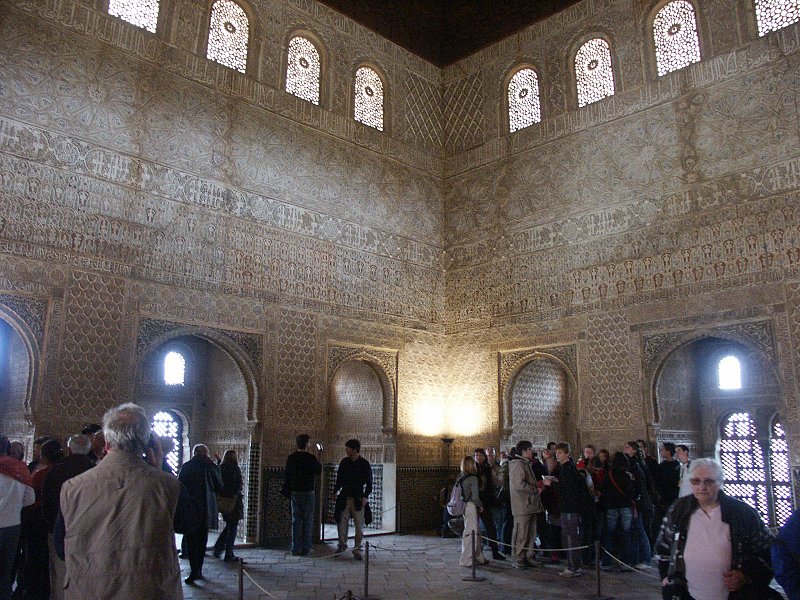
Hall of the Ambassadors
The Hall of the Ambassadors was square, 37 feet on each side, and 75 feet tall. All the walls contain three arched doors that lead to rooms and balconies. The stucco carvings include the usual Muslim themes, and the inscriptions are taken from poems and the Koran. Many of the inscriptions call for Allah to save the people from the devil: “My help from the wrath of God and from all the devil who allows the breaking of hell; and free me from the evil of the envious when he is ready to envy. And there is no other living divinity than that of God whom I must praise eternally. The praise of the God of the centuries.”
The center niche on the wall to the right contained the throne. On March 31, 1492, the Alhambra Decree (Edict of Expulsion) was signed by Isabel and Ferdinand in the Hall of Ambassadors. Jews had until July 31, 1492, to either convert to Catholicism or leave Spain. Don Isaac Abravenel, a Portuguese Jew and respected councilor and financier who funded the voyage of Columbus to the new world, and Abraham Seneours, a Sephardic rabbi and senior member of the Castile government, plead not to sign the document to no avail. Abravenel emigrated and Seneours converted. The humanitarian crisis was enormous. Thousands of Jews went into exile.
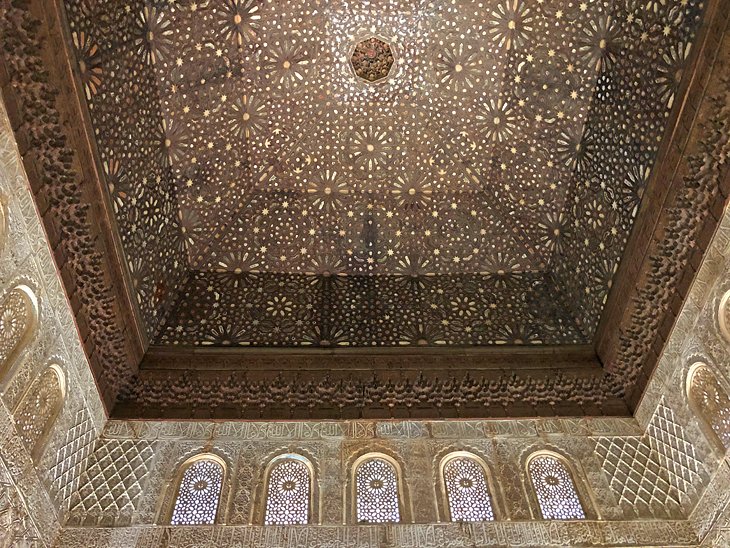
Hall of the Ambassadors Ceiling
From the square room of Earth to the circular dome of Heaven, the Hall of the Ambassadors was constructed with the finest materials and technology the Muslims had developed. The ceiling was constructed of 8017 interlinked pieces of cedar wood and embedded with lapis lazuli to represent the Seven Heavens of Islamic Paradise. The dead are transported to one of the Seven Heavens
based upon their respective virtues. Lapis Lazuli, deep blue in color, is a semi-precious stone deemed sacred since ancient times. Its name comes from the Persian word lazward (gem) and the word azure (blue) from several languages.
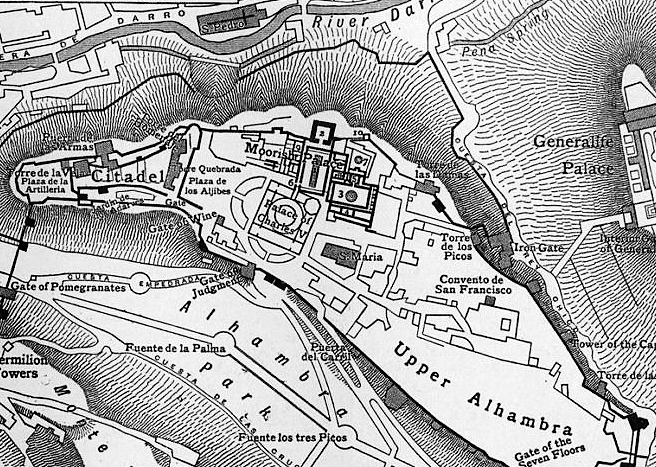
Plan of the Alhambra
The Alhambra covers 35 acres on the Sabika Hill. The Citadel/Fortress can be seen at the left. The Moorish palace of the Nasrids is at the center top of the plan. The Hall of the Ambassadors, marked #2, projects beyond the Courtyard of the Myrtles, the center of the palace. The Courtyard of the Lions is marked #3. Two small rooms just behind the courtyard are the Hall of Abencerrojes, marked #4, and the Hall of the Two Sisters, marked #5. The other buildings were constructed after1492 by the Catholic rulers. This image is cropped, but the gardens, called Generalife, continue in all directions.
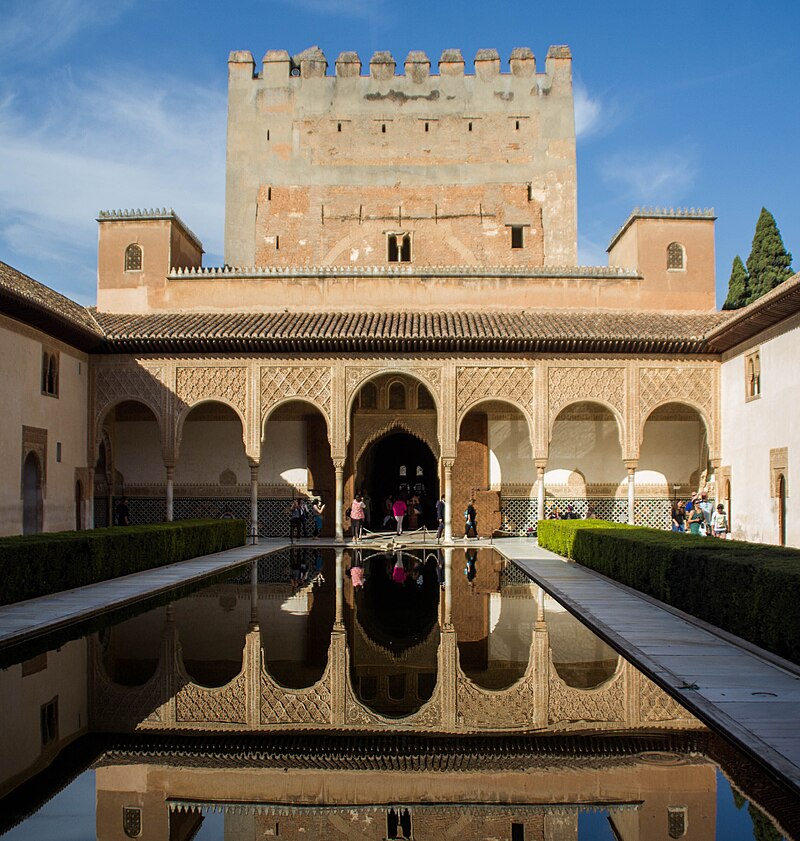
Patio de los Arrayanes (Courtyard of the Myrtles) (1314-1325)
Patio de los Arrayanes (Courtyard of the Myrtles) (1314-1325) was built by Isma’il I, fifth Nasrid sultan, and modified by his successors. The courtyard contains a reflecting pool that is140 feet long and 74 feet wide. Its name comes from the hedges of myrtle trees that were planted on both sides of the pool. Myrtles trees had white flowers and a sweet fragrance. For Jews, myrtles are one of the four plants used to build temporary huts, called sukkah, to celebrate God’s protection during their 40 years of wandering after the Exodus. For Christians, myrtles represent the promise of restoration and a blessing, their fragrance a divine favor. The Comares tower can be seen at the end of the courtyard. The pool was designed so that no movement of the water would alter the reflection of the tower. The horseshoe arches are decorated with stucco carvings.
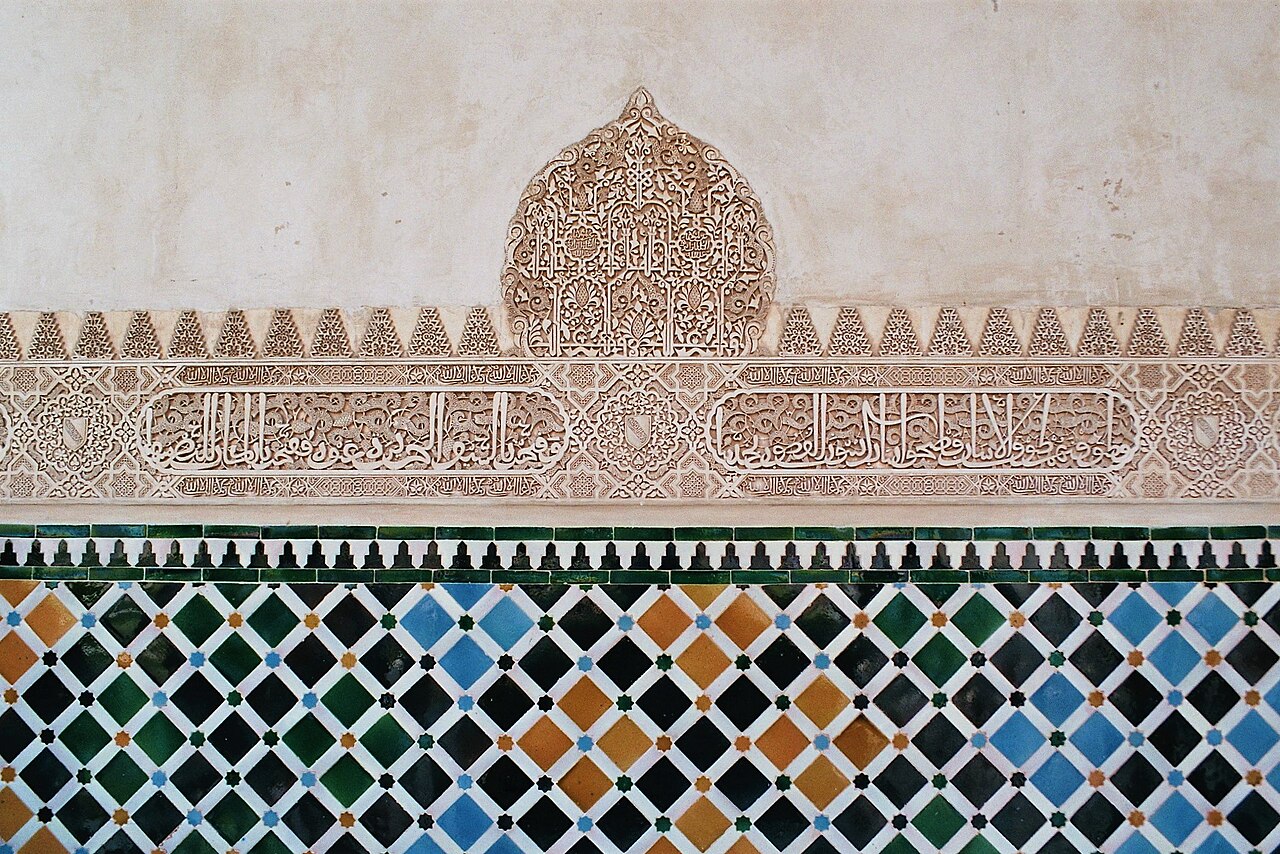
Tile and Trees of Life
The tiled wall at the end of the courtyard represents the wide variety of Islamic geometric patterns. On top of the tile are continuous stucco carvings including Tree of Life designs. The Koran mentions the Tree of Immortality from which Adam was forbidden to eat the fruit. Although the image is used frequently, it does not have a specific religious meaning. The branches extending from a central core represent personal spiritual growth and development and the proliferation of the faith.

Patio of the Lions (1362)
Mohammad V built the Patio of the Lions in 1362. Located on the east side of the Comares Palace, the courtyard is 116 feet long and 66 feet wide. It is surrounded by 124 white marble columns. The famous dodecagon (12-sided) fountain with its twelve white marble lions sits at the center. The rooms off the courtyard were the private quarters of the royal family and harem.
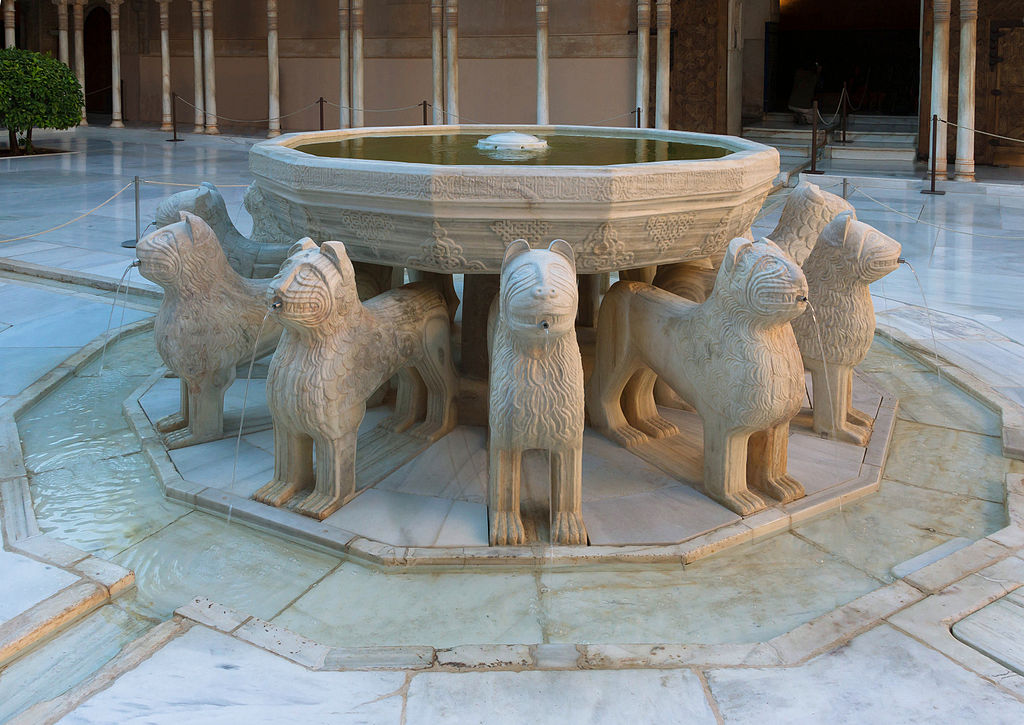
Lions Fountain
The lions represent the twelve tribes of Israel from the Torah (Old Testament). They were a gift to Mohammad V from the Jews. Water flowed from the center of the fountain and out the mouths of the lions. The inscription around the rim of the basin is a poem by Ibn Zamrak (1333-1393), an Andalusian Arab. His poetry can be found in many places in the Alhambra. The text of the poem describes the beautiful fountain, the strength of lions, and the hydraulic system and how it worked.
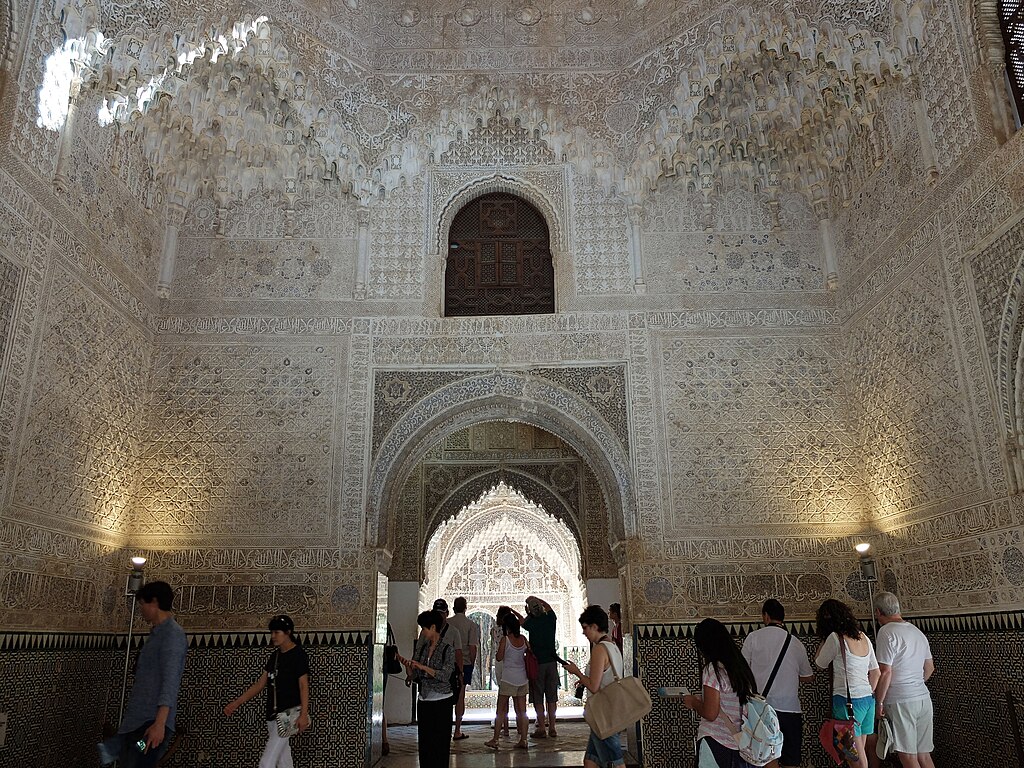
Hall of Two Sisters
Sultan Mohammed V built The Hall of Two Sisters to serve as the residence of his wife and the royal family. The two large slabs of marble that form part of the floor inspired the name. No part of the wall and ceiling is undecorated, and the muqarnas ceiling is considered one of the finest examples of Nasrid architecture. The base of the dome appears to be hanging lace.

Hall of Two Sisters Dome
The dome is eight-sided with sixteen windows. It is constructed with over 5000 small wedge-shaped wooden muqarnas that form 16 lacey domes and the central flower shape. A simpler form of muqarnas was used in the construction of the Great Mosque of Cordoba, and elaborated over time by Muslim architects until they achieved this form.

Hall of Two Sisters Ceiling Muqarnas
Here the muqarnas were painted white. Turquoise, amber, and gold paint was used to create the intricate surface detail
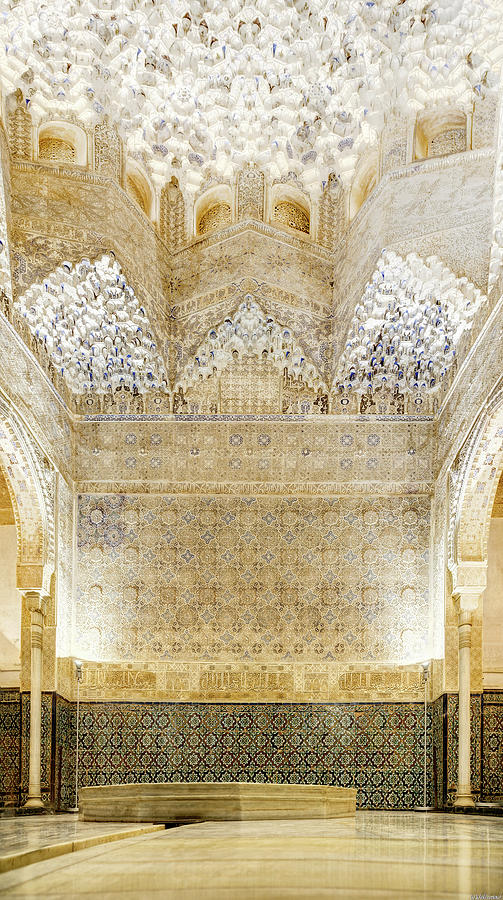
Hall of the Abencerrages
The Hall of the Abencerrages (sons of the saddler) is another example of elegant Nasrid architecture. Abu al-Hasan Ali, who ruled from 1464 until 1485, suspected one of the Abencerrages knights was having an affair with his favorite slave, who became his wife. He invited 30 chiefs of the Abencerrages to a banquet in the Hall, and he had them all beheaded. The heads were piled in the fountain. The stain remains on the floor where the fountain water ran red.
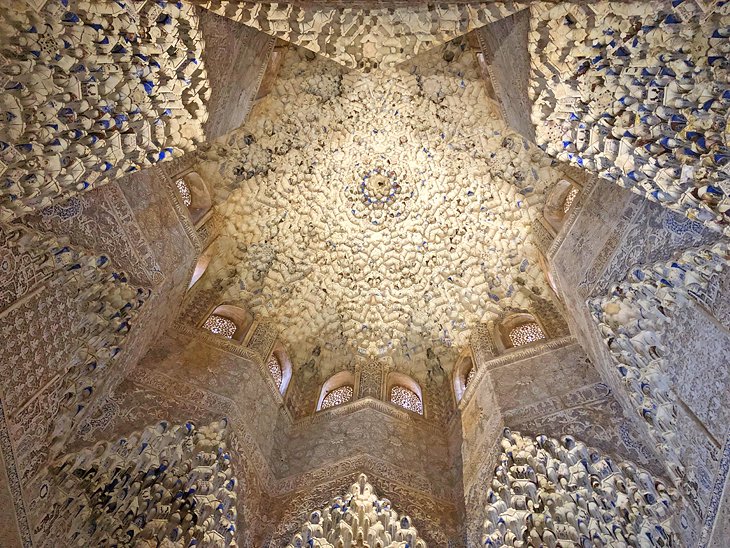
Hall of the Abencerrages Dome
The eight-pointed star design contains 16 windows. The dome rises above the windows.
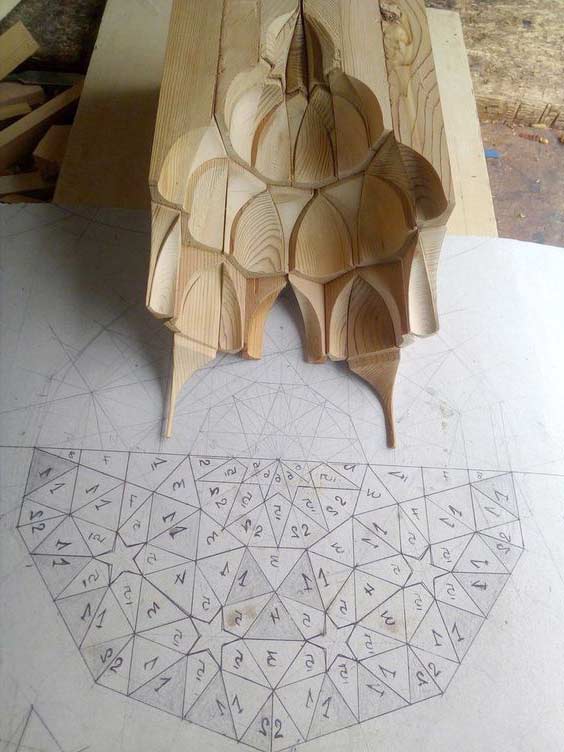
Model of Muqarnas
The muqarnas structure is a complex mathematical development which the Muslims used most successfully.

Generalife
The extensive gardens that surround the palaces are known as the Generalife. The name is Arabic, Jannat al-arifa. Jannat means paradise. Water channels, walkways, stairs, fountains, trees, flowers, fruits, and vegetables abound. Artistry and intellect are combined. The sights and smells of the garden create a sense of paradise. A passage in the Koran 2:25 describes “gardens, underneath which running waters flow…”
Washington Irving lived in one of the Alhambra apartments for three months. A plaque marks his apartment. He wrote Tales of the Alhambra (1832), a collection of essays that brought international recognition to the Alhambra. When he first arrived in Grenada, he described it as, “a most picturesque and beautiful city, situated in one of the loveliest landscapes that I have ever seen.” After his stay he said, “How unworthy is my scribbling of the place.”
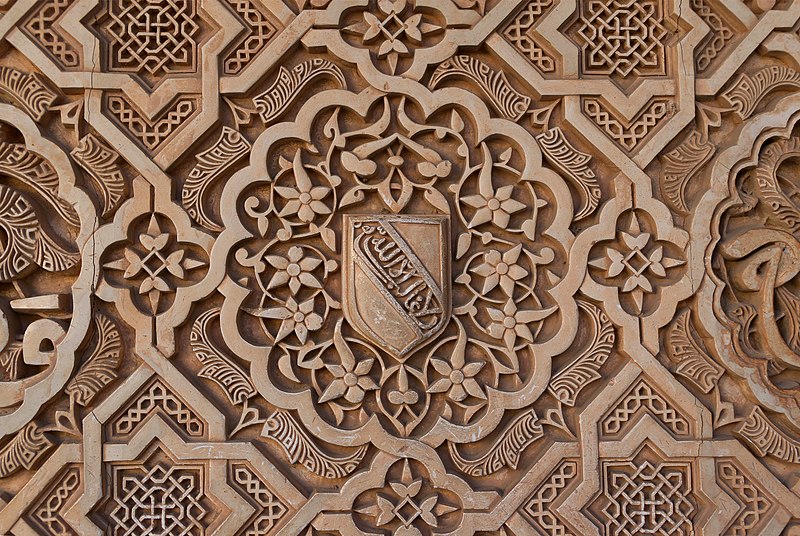
Crest of the Nasrids (1013-1492)
Beverly Hall Smith was a professor of art history for 40 years. Since retiring to Chestertown with her husband Kurt in 2014, she has taught art history classes at WC-ALL and the Institute of Adult Learning, Centreville. An artist, she sometimes exhibits work at River Arts. She also paints sets for the Garfield Theater in Chestertown.



Write a Letter to the Editor on this Article
We encourage readers to offer their point of view on this article by submitting the following form. Editing is sometimes necessary and is done at the discretion of the editorial staff.